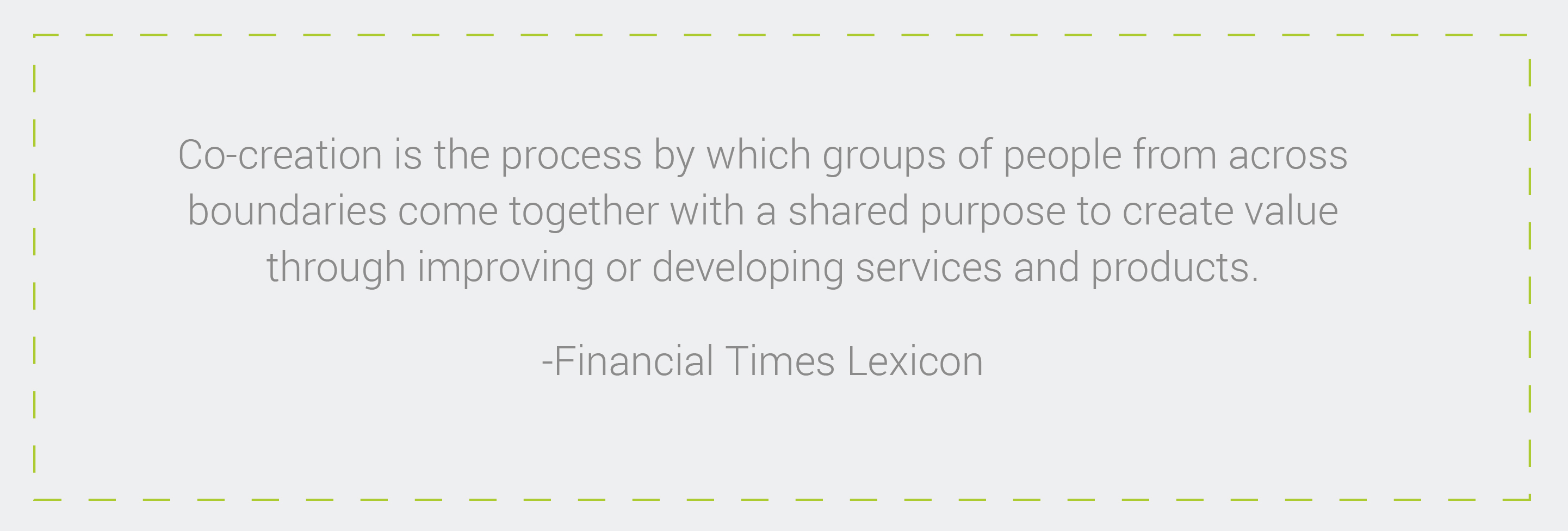Design Strategy
Co-creation: The Effective Approach to Innovative Thinking
At the root of good product, service or system design is the desire to create something of use and value to the intended end user. So if your goal is to create good design, keeping your focus on either solving the end user’s problem or enhancing his existing experience is key to getting you there.
In the past, when developing new products or improving existing ones, innovation, in general, was based on the interpretation of information gathered via market research. It was restrictive in its approach.
A more recent innovation technique that is particularly effective in today’s world is co-creation.
About ten years ago, it was observed that: “Companies today are moving from just collecting customer reactions to actively inviting customers to participate in creating and developing new products. The traditional company-centric approach to product innovation is giving way to a world in which companies co-create products with consumers.” *
The concept of co-creation has evolved since then and today it has expanded to allow not only customers, but also other stakeholders and professionals to be a part of the innovation process. The Financial Times Lexicon definition explains the evolved concept well:

HOW CO-CREATION ENABLES CONTEMPORARY INNOVATION
The problems and needs of people today are much more complex and interconnected than they were 20 years ago, requiring more innovative solutions than ever before. Co-creation, being multi-pronged in its approach, has the power to enable us to progress:
1. From Obscurity to Clarity

Complex problems can be difficult to break down. As opposed to many other approaches, co-creation often takes place at the beginning of the innovation process and involves the end user right from the start. This means that even before you begin the ideation phase, you are one step closer to creating value – by obtaining a true understanding of what the end user really requires. It’s like a doctor prescribing treatment for your ailment – the treatment will only be effective if a correct diagnosis has been made.
2. From Detachment to Empathy

Co-creation gives designers, business owners, researchers, vendors and other stakeholders the opportunity to get into the shoes of the end user. If you learn to empathise, you are more likely to approach the task at hand with greater compassion. In other words, you are more likely to create appropriate and valuable solutions.
3. From Alienation to Involvement

Co-creation encourages responsible co-ownership – when the parties involved in the process feel empowered to make a difference and have a stake in the outcome, they are likely to be more invested.
4. From Rigidity to Customisation

By enabling participation of the end user and offering customisation, co-creation allows you to do more than just problem solve; it provides you with a means to enable customer delight, a valuable element in building and maintaining brand loyalty in today’s highly competitive market place.
5. From Uncertainty to Cohesiveness

Complexity is fraught with uncertainty. By bringing varied expertise to the table, co-creation allows a complex problem to be examined from several angles. This cohesive approach allows you to transform fragmented ideas into robust, effective solutions.
Co-creation, like the Internet, empowers you to use the collective force of a group to enhance lives and the world you live in.
It is this intrinsic synergy of co-creation that enables us to deliver innovative solutions, even in the face of today’s highly complex and ever evolving environment.
*Peter C. Honebein and Roy F. Cammarano, “Customers at Work,” Marketing Management 15, no.8 (January-February 2006): 26-31; Peter C. Honebein and Roy F. Cammarano, Creating Do-It-Yourself Customers: How Great Customer Experiences Build Great Companies (Mason, OH: Texere Southwestern Educational Publishing, 2005).















Trackbacks for this post